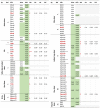A Selection of 14 Tetrameric Microsatellite Markers for Genetic Investigations in Fallow Deer (Dama dama)
- PMID: 37443886
- PMCID: PMC10339914
- DOI: 10.3390/ani13132083
A Selection of 14 Tetrameric Microsatellite Markers for Genetic Investigations in Fallow Deer (Dama dama)
Abstract
The fallow deer (Dama dama) represents significant game management value globally, and human activities are significantly impacting the species. Besides the positive effects, these activities can threaten its existence, health, and value. The aim of the authors was to develop a tetranucleotide microsatellite panel that could be clearly interpreted and used for genetic testing of fallow deer. Such a panel did not exist until now and could be particularly useful in the field of conservation genetics and forensics. A total of 99 tetrameric microsatellites, originally designed for related deer species, were tested on 20 fallow deer individuals from five Hungarian sampling areas. Original and newly designed primers were used to amplify the microsatellite regions using previously published or optimized PCR protocols. The lengths and sequences of specific amplicons were detected using capillary electrophoresis, and the rate of polymorphism was determined. Altogether, 80 markers provided PCR products of adequate quality and quantity. Among them, 15 markers proved to be polymorphic (2-5 alleles/locus), and 14 tetrameric markers were selected for further analysis. Statistical calculations showed that the selected polymorphic microsatellites can potentially enable key individualization in many areas of wildlife and population genetics, thus protecting the species.
Keywords: fallow deer (Dama dama); individual identification; tetrameric microsatellites (tetra-STRs); wildlife and population genetics.
Conflict of interest statement
The authors declare that they have no interests that could have appeared to influence the work reported in this paper.
Figures

References
-
- Chapman N., Chapman D. The Distribution of Fallow Deer: A Worldwide Review. Mammal Rev. 2008;10:61–138. doi: 10.1111/j.1365-2907.1980.tb00234.x. - DOI
-
- Esattore B., Saggiomo L., Sensi M., Francia V., Cherin M. Tell Me What You Eat and I’ll Tell You…where You Live: An Updated Review of the Worldwide Distribution and Foraging Ecology of the Fallow Deer (Dama Dama) Mamm. Biol. 2022;102:321–338. doi: 10.1007/s42991-022-00250-6. - DOI
-
- Corlatti L., Zachos F.E. Terrestrial Cetartiodactyla. Springer Nature; Berlin/Heidelberg, Germany: 2022.
-
- Bijl H., Csányi S. Fallow Deer (Dama Dama) Population and Harvest Changes in Europe since the Early 1980s. Sustainability. 2022;14:12198. doi: 10.3390/su141912198. - DOI
-
- Elek B. The Criminalization of Poaching in Hungary. Zbornik radova Pravnog fakulteta Novi Sad. 2019;53:639–648. doi: 10.5937/zrpfns53-20330. - DOI
Grants and funding
LinkOut - more resources
Full Text Sources

